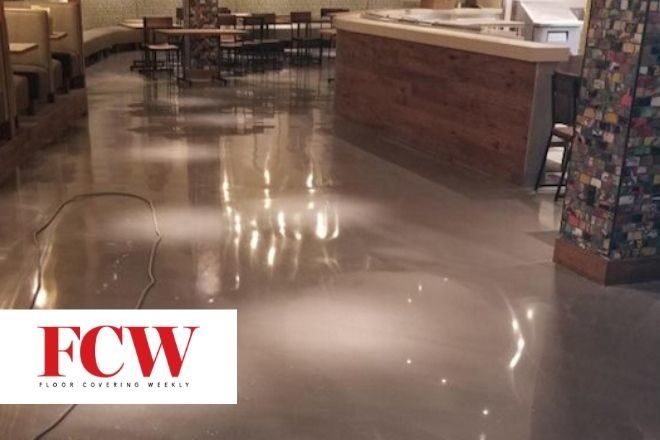
“Polished concrete continues to disrupt other product categories and much like LVT it will take market share from lots of other surfaces.” — Mark Bischoff, Starnet
With its performance attributes, durability and on-trend visual, the polished concrete market continues to shine in the commercial market — be it retail, corporate, high-rise residential, among other high-traffic spaces — even taking share from other hard surface floor coverings including resilient and VCT.
Large national retailers having polished concrete in their stores, warehouses and distribution centers has given credibility to the industry.
“Major giants like Amazon, Lowes, Walmart and Home Depot are proving the value of polished concrete and general contractors are selling polished concrete as a less expensive alternative,” George White, field supervisor of James Floor Covering in Bristol, Pa explained to FCW. “Polished concrete’s unique qualities are appealing.”
And this validation from these giant businesses, offered John McGrath, director of INSTALL, is an eye opener for floorcovering decision-makers. “Upon inspection, they also learn of the maintenance, safety, sustainability and aesthetic strengths delivered through polished concrete,” said McGrath. “It is sturdy, cost-effective, easy to maintain, helps with lighting and slip co-efficiency. As credible training and professional installation teams become more available, polished concrete will increase in demand.”
Benefits Help Stake Claim
Indeed, polished concrete offers a number of benefits including sustainable properties and moisture mitigation. “That’s a big one,” said Jennifer Faller, consultant at Concrete Insite. “Polished concrete is sustainable and in light of COVID, this is especially important. There’s also no inventory issues or waiting on shipments from China or from other manufacturers.”
Energy use and contributing to LEED credits is another benefit. “We first started seeing and hearing about polished concrete in the A & D community when LEED and USGBC saw their initial push in the marketplace,” said Starnet president Mark Bischoff. “As it becomes more prevalent across the market, building owners and property owners are seeing the look and wanting to adopt it to their own space.”
Polished concrete is being installed everywhere, said McGrath. “To rank where I see it based on square footage: industrial, retail, corporate, educational and high-rise residential settings.” And while the industry started seeing polished concrete’s popularity begin to grow in the late 90s early 2000s, Bischoff said it has only picked up steam as it caught the eye of designers. “Certain parts of the country — for instance, California and Western, Pa. — were very quick to its initial use and from there it informed the rest of the design community and became trendy,” he said.
Fuse member Jeff Bennett of Business Flooring Specialists with locations in Dallas, Fort Worth and Houston, said polished concrete provides a broad range of design and style options different from what’s been available in the past. “Designers are becoming more familiar and comfortable specifying polished concrete,” he said. “Every polished concrete floor has its own unique characteristics and visual — no two are alike.”
What’s more, new technology has allowed polished concrete to improve its performance and durability. “It got over the hump of failing so badly; manufacturers are paying attention and introducing technology to address polished concrete’s shortcomings and it’s worth it from a monetary standpoint,” said Faller. “Polished concrete used to be a tiny market and now it’s massive. Forty percent of Fuse members are in polished concrete.” Polished concrete is indeed a massive market and although it is difficult to quantify, Faller pegs it at about an $800 million to $1 billion industry per year. “With the advent of power trowels and outfitting trowels with diamonds, over the last seven years especially, polished concrete has gotten pretty good from a quality perspective,” she said.
Eric Boender, Starnet’s vice president of business development, said there’s also been an expansion of coatings for concrete that offer an enhanced finish. “For instance, great reflection and better cleanability,” he said. “The business is changing; the steps have expanded. It’s not just overlay and coatings, there are many ways to accomplish a finished floor look.”
Big Investment, Big Reward
As great as polished concrete is, however, it does have a rather high cost of entry — beginning somewhere around the $40,000 mark for the right equipment and a trained crew.
“Many members hold back on getting into this business because of its high investment and risk, bidding the project incorrectly and finding the experienced, competent leader is a big challenge for many flooring contractors,” said Boender. “It’s a specialty product, more service-related, so the margins are higher in the polished concrete business but a higher overhead.”
Another challenge, said Bennett, is that it’s difficult to guarantee the end result. “The end result is a function of the quality and condition of the canvas,” he said, adding as well, “Existing concrete slabs have various conditions such as trenches, multiple pours, chemicals and contaminants, flatness of the floor. There could also be a lack of consistency with the aggregate size, shape and depth.” But entering into the polished concrete market remains a key strategy for many flooring contractors, explained Bischoff, because it expands the kinds of services you can offer and increases your value to customers. “Most clients want to have a relationship with one contractor and our Starnet members want to be that full-service provider of choice,” said Bischoff. “So if you want to be someone to facilitate the needs of all customers, you need to be in the concrete polishing business.”
*This article originally appeared in Floor Covering Weekly (FCW) and contains contributions from INSTALL executive director John T. McGrath, Jr.
